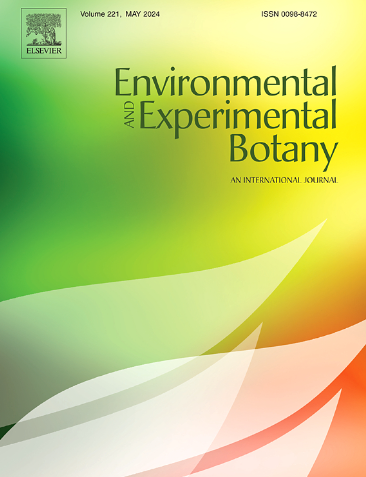盐胁迫下硫酸盐和其他阴离子对蚕豆叶片外胞体pH和气孔关闭的影响
IF 4.7
2区 生物学
Q2 ENVIRONMENTAL SCIENCES
引用次数: 0
摘要
植物根部感受到的盐分诱导胁迫会引起植物复杂的系统性生理反应,其中离子失衡和渗透压在调节气孔方面起着关键作用。本研究探讨了不同阴离子(Cl-、NO3-、SO42- 和 PO43-)如何影响盐碱条件下蚕豆根和叶的凋亡体 pH 值(pHapo)以及气孔关闭。利用基于显微镜的实时 pHapo 成像方法,我们证明了叶片凋亡体中的瞬时碱化是阴离子特异性的,并随叶片成熟度而变化,Cl- 和 NO3- 比 SO42- 和 PO43- 能引起更强的 pHapo 上升。值得注意的是,根凋亡体的 pH 值不受短期盐度的影响,这说明碱化作用发生在嫩枝上,可能与木质部转移的离子效应有关。研究结果表明,无论凋落物碱化的程度如何,气孔孔径都会在不同的处理中减小。在所研究的阴离子中,SO42- 显示出独特的调节潜力,表明其在气孔行为中的作用。这些结果为离子胁迫、凋亡体 pH 值调节和气孔反应之间的相互作用提供了新的见解,为提高作物的耐盐性提供了潜在的目标。本文章由计算机程序翻译,如有差异,请以英文原文为准。
Influence of sulphate and other anions on leaf apoplastic pH and stomatal closure in Vicia faba under salinity stress
Salinity-induced stress perceived at plant roots elicits complex systemically orchestrated physiological responses in plants, with ionic imbalances and osmotic pressures playing pivotal roles in modulating stomatal regulation. This study investigates how different anions (Cl–, NO3–, SO42–, and PO43–) influence root and leaf apoplastic pH (pHapo) and stomatal closure in Vicia faba under saline conditions. Using a microscopy-based real-time pHapo imaging approach, we demonstrate that transient alkalinisation in the leaf apoplast is anion-specific and varies with leaf maturity, with Cl– and NO3– eliciting stronger pHapo increases than SO42– and PO43–. Notably, the root apoplast pH remained unaffected by short-term salinity, highlighting that the alkalinisation is localised to the shoot and likely linked to xylem-translocated ionic effects. Findings reveal that stomatal aperture reductions occurred across treatments regardless of the magnitude of apoplastic alkalinisation. Among the anions studied, SO42– displayed unique regulatory potential, suggesting a role in stomatal behaviour. These results provide new insights into the interplay between ionic stress, apoplastic pH regulation, and stomatal responses, offering potential targets for improving salinity tolerance in crops.
求助全文
通过发布文献求助,成功后即可免费获取论文全文。
去求助
来源期刊

Environmental and Experimental Botany
环境科学-环境科学
CiteScore
9.30
自引率
5.30%
发文量
342
审稿时长
26 days
期刊介绍:
Environmental and Experimental Botany (EEB) publishes research papers on the physical, chemical, biological, molecular mechanisms and processes involved in the responses of plants to their environment.
In addition to research papers, the journal includes review articles. Submission is in agreement with the Editors-in-Chief.
The Journal also publishes special issues which are built by invited guest editors and are related to the main themes of EEB.
The areas covered by the Journal include:
(1) Responses of plants to heavy metals and pollutants
(2) Plant/water interactions (salinity, drought, flooding)
(3) Responses of plants to radiations ranging from UV-B to infrared
(4) Plant/atmosphere relations (ozone, CO2 , temperature)
(5) Global change impacts on plant ecophysiology
(6) Biotic interactions involving environmental factors.
 求助内容:
求助内容: 应助结果提醒方式:
应助结果提醒方式:


